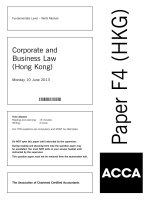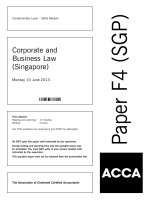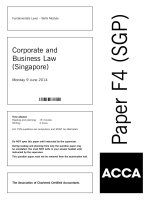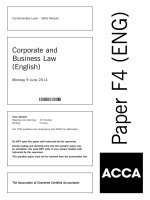Acca f4 corporate and business law singapore 2012 dec answer
Bạn đang xem bản rút gọn của tài liệu. Xem và tải ngay bản đầy đủ của tài liệu tại đây (88.87 KB, 9 trang )
Answers
Fundamentals Level – Skills Module, Paper F4 (SGP)
Corporate and Business Law (Singapore)
1
December 2012 Answers
In interpreting a statute, the objective of the court is to ascertain the intention of Parliament as expressed in the words used in the
statute.
(a)
The literal rule is usually the first rule applied by judges. Under the literal rule, the words of the statute are given their natural
or ordinary meaning and applied without the judge seeking to put a gloss on the words or seek to make sense of the statute.
Thus, words are given their literal meanings in the context of the provision and the statute as a whole.
For example, in Fisher v Bell (1961), the defendant had a flick knife displayed in his shop window with a price tag on it.
Statute made it a criminal offence to ‘offer’ such flick knives for sale. The court applied the literal rule of statutory interpretation
and quashed his conviction because goods on display in shops were not ‘offers’ but invitations to treat.
(b)
Under the ejusdem generis rule, where a list of two or more specific words is followed by more general words, the otherwise
wide meaning of the general words must be restricted to the same class, if any, of the specific words that precede them.
For example, where ‘cars, motor cycles, motor powered vehicles’ are mentioned, the word ‘vehicles’ will be interpreted in a
limited sense as those that move on land and do not include airplanes.
(c)
The mischief rule is applied in situations where there is an ambiguity in the meaning of the words in a statute. When using
the mischief rule, the court interprets the statute by considering the common law position prior to the statute, the mischief or
defect for which the common law did not provide and the remedy Parliament had resolved and appointed to cure the defect.
For example, in Elliot v Grey (1960), the defendant’s car was parked on the road. It was jacked up and had its battery
removed. He was charged with an offence, under the Road Traffic Act 1930, of using an uninsured vehicle on the road. The
defendant argued that he was not ‘using’ the car on the road as clearly it was not driveable. The court applied the mischief
rule and held that the car was being used on the road as it represented a hazard and therefore insurance would be required
in the event of an incident. The statute was aimed at ensuring people were compensated when injured due to the hazards
created by others.
2
(a)
The general rule is that the offeror cannot state that the silence of the offeree may be treated as acceptance. In Felthouse v
Bindley (1862), the plaintiff offered to buy his nephew’s horse and stated, ‘If I hear no more about him, I consider the horse
mine’ at a certain price. The nephew made no reply and the horse was sold to someone else. The plaintiff sued. The court
held the offeror cannot impose silence on the offeree and so there was no contract.
However, it is not the case that silence can never amount to acceptance. For instance, since the rule is to benefit the offeree,
if both the offeree and offeror agree that silence can amount to acceptance, then silence can indeed amount to acceptance.
It may also be possible for the offeror to waive the requirement of communication of acceptance. This is especially so in
unilateral contracts such as in Carlill v Carbolic Smoke Ball Co (1892). In that case, the court held that the offeror had
impliedly dispensed with the requirement for the offeree to communicate her acceptance to the offeror and so there was still
a valid contract.
(b)
Assuming the contract does not have a specific provision governing the matter, the general rule is that acceptance is effective
only when received. If this is not the case, odd results may occur as observed in Entores Ltd v Miles Far East Corpn (1955):
‘An acceptor could say: ‘I spoke the words of acceptance in your presence, albeit softly, and it matters not that you did not
hear me’, or ‘I telephoned to you and accepted, and it matters not that the telephone went dead and you did not get my
message.’
This general rule also extends to other means of communications such as telexes. Entores Ltd v Miles Far East Corpn was a
case concerning telex messages, and the court held that acceptance was effectively communicated when received. Further,
it would appear from Reese Bros Plastics v Hamon-Sobelco Australia Pty Ltd (1988) that for facsimile transmissions,
acceptance is also effective only when received.
The exception to the rule that acceptance is effective when received is the postal rule. In Adams v Lindsell (1818), the
defendant wrote to the plaintiff offering to sell him wool and asked him to reply by post. The plaintiff replied on the 5th but
the letter reached the defendant only on the 9th. Meanwhile, on the 8th, not hearing anything from the plaintiff, the defendant
sold the wool to a third party. The plaintiff sued the defendant and the court held that the acceptance was effective when the
letter was posted and so there was a contract.
3
(a)
Discharge of contract means the termination of a contractual relationship between the parties. A contract is said to be
discharged when it ceases to operate, i.e. when the rights and obligations created by it comes to an end.
Performance means the doing of that which is required by the contract. A contract becomes discharged through performance
where both parties have fully performed their contractual obligations.
The general rule is that the parties must perform precisely all the terms of the contract in order to discharge their obligations.
7
If one party does not fully perform the contract this will amount to a breach of contract and the other party may usually have
a claim for damages. If the non-performance amounts to a repudiatory breach (breach of condition) the other party will be
released from his or her obligations.
Where a contract is one where the price is payable on completion, then completion is generally required in order to discharge
the contract. This is often expressed in the terms of being a condition precedent. Completion triggers the requirement of
payment: no completion, no payment. This general rule was established in Cutter v Powell (1795). In that case, the claimant's
husband agreed by contract to act as a second mate on the ship the ‘Governor Parry’ on a return voyage to Jamaica. The
voyage was to take eight weeks and he was to be paid on completion. A term in the contract stated:
‘Ten days after the ship ‘Governor Parry’, myself master, arrives at Liverpool, I promise to pay to Mr. T. Cutter the sum of thirty
guineas, provided he proceeds, continues and does his duty as second mate in the said ship from hence to the port of
Liverpool. Kingston, July 31, 1793.’
Six weeks into the voyage the claimant's husband died. The claimant sought to claim a sum to represent the six weeks work
undertaken. The wife’s action failed. The court held that payment was on condition that he worked the ship to Liverpool and
since he did not fulfil this condition, the widow was entitled to nothing.
(b)
If the general rule, that for performance to be effective there must be precise and complete performance, were maintained in
full rigour, it would frequently lead to injustice. There are four exceptions to this general rule:
(i)
Substantial performance
If there is no complete performance, but there is substantial performance, the party performing may nonetheless be able
to claim the contract price, less the cost of making good any omissions or defects in execution. Whether there is
substantial performance would depend on the facts of each case. In Hoenig v Isaacs (1952), Hoenig was engaged to
decorate Isaacs’ flat for £750. He decorated the flat, but a wardrobe door and bookshelf were defective. The court held
that there was substantial performance and Hoenig was entitled to claim payment, less the cost of remedying the
defects, which amounted to £56. However, if the obligation under the contract is an entire one, even if there is
substantial performance, it may not be possible to make a claim. For instance, if X agrees to paint Y’s portrait and has
painted everything except Y’s eyes, it is unlikely that X would be able to make a claim.
(ii)
Divisible contracts
Certain contracts may be divisible into stages and so, after each stage is completed, the party performing would be
entitled to payment. Common examples of such contracts are modern-day employment and building contracts. In the
case of employment contracts, for instance, it is usually divided into weeks or months, and the employee would be
entitled to payment after the completion of each period and would not have to wait for the end of the contract of
employment. Similarly, in building contracts, usually it would be provided that payment would be made at each stage
of completion of the project, upon the presentation of the architect’s certificate that that stage has been completed.
(iii) Prevented performance
If one party has begun performing his obligations, but has been prevented by the other from continuing, the party who
has performed part of the contract may nonetheless be entitled to payment on a quantum meruit basis, that is, payment
based on the value of services rendered. In Planche v Colburn (1831), Planche agreed to author a publication for
Colburn. However, after Planche had started work, Colburn abandoned the project. Planche sued Colburn and the court
held that Planche was entitled to be paid on a quantum meruit basis, as he was prevented from performing the contract
by Colburn’s actions.
(iv) Acceptance of partial performance
If one party has not completely performed his obligations, and the other party, by words or actions intimates that he
accepts the incomplete performance, the party who has not completely performed the contract may nonetheless be able
to claim on a quantum meruit basis. Thus, if a seller delivers less goods than as required under the contract, the buyer
can generally reject the whole lot. However, if he decides to accept the lesser quantity delivered, he has to pay for the
quantity he accepts. However, there would be no acceptance if the other party to the contract has no choice but to accept
the incomplete performance. In Sumpter v Hedges (1898), Sumpter was engaged by Hedges to construct a structure
on Hedge’s land. Sumpter failed to complete the job, so Hedges had to complete the rest of the job. Sumpter sued for
the value of work done. The court held that he need not be paid as Hedges had no choice but to accept the partially
completed structure. Hedges could not reasonably be expected to knock it down or leave it standing on his land in its
partially completed state.
Tutorial note: Full marks will be awarded for explaining any THREE exceptions.
4
A limited liability partnership (LLP) is a business organisation comprising two or more persons associated for carrying on a lawful
business with a view to profit that is registered as such under the Limited Liability Partnership Act. Despite its name, it is not
regarded as a partnership and general partnership law does not apply to LLPs.
(a)
Section 4 LLP Act provides that the LLP is a body corporate that has a separate legal personality from its partners. It has
perpetual succession. Any change in the partners of a LLP will not affect the existence, rights or liabilities of the LLP.
Section 5 LLP Act provides that the LLP can sue, be sued, own property in its own name, and do acts that bodies corporate
may lawfully do.
8
5
(b)
Section 9 LLP Act provides that every partner of the LLP is regarded as an agent of the LLP. Thus a partner would have
authority to bind the LLP to contracts entered into in the course of its business. Section 9(2) LLP Act provides that the LLP
is nevertheless not bound by the acts of a partner which are not authorised, where either this fact is known to the person
dealing with the partner or the person does not know or believe the partner to be a partner in the LLP.
(c)
Section 8 LLP provides that an obligation of the LLP is solely the obligation of the LLP. A partner is not personally liable for
an obligation of a LLP solely by reason of being a partner of a LLP. This shield for innocent partners of a LLP applies to both
tort and contracts entered into in the course of the LLP’s business. Section 8(3) LLP Act provides that a partner will be
personally liable for his own wrongful acts or omissions, although he will not be personally liable for the wrongful acts or
omissions of any other partner of the LLP. Section 8(4) LLP Act provides that where a partner of a limited liability partnership
is liable to any person (other than another partner of the limited liability partnership) as a result of a wrongful act or omission
of his in the course of the business of the limited liability partnership or with its authority, the limited liability partnership is
liable to the same extent as the partner.
(a)
A promoter is treated as a fiduciary of the company that he promotes and, therefore, owes certain fiduciary duties to the
company. His primary duty towards the company is not to make a profit out of the promotion without adequate disclosure.
A promoter must disclose any profit or benefit that he makes or receives in the promotion of the company. This commonly
occurs where the promoter has sold something to the company. When the question of ratification of the sale arises, the
promoter must disclose his interest to the company. A ‘disclosure’ to persons who are puppets of the promoters will be
insufficient.
In Erlanger v New Sombero Phosphate Co (1878), Erlanger and several associates formed a syndicate to acquire the lease
of an island in the West Indies for £55,000. The idea was to mine the island for phosphates. The members of the syndicate
incorporated the company and became its first directors. The lease was sold to the company for £110,000. The purchase
was ratified by the board of directors. Members of the public subscribed for capital in the company. When the first shipments
of phosphate proved to be a failure, the members sacked the board and appointed a new one. The new board of directors
sought to have the contract rescinded. The House of Lords held that since the promoters had not disclosed their interest in
the transaction to an independent board of directors, recission of the contract was possible.
A commission or payment that a promoter receives upon transfer of property to a company must also be disclosed.
In Whaley Bridge Calico Printing Co v Green and Smith (1879), Green purchased certain calico printing works for the price
of £15,000. He purported to sell them to Smith for £20,000. This was a sham transaction entered into to facilitate the
subsequent sale of the property to the company. Green and Smith formed the company in October 1876. The works were
sold to the company purportedly by Smith in February 1877. Green promised to pay Smith £3,000 out of the money that
he received. This commission was not disclosed to the company. The court held that Smith would have been liable to account
for the money had it been paid over to him. On the facts, Green had not yet paid the full amount over to Smith. The company
was allowed to recover the unpaid balance of the secret commission from Green.
If a promoter contracts with the company whether as vendor or purchaser, the fact that he is a contracting party must be
disclosed.
In Habib Abdul Rahman v Abdul Cader (1886), Abdul Cader and another person promoted the company, which bought a
piece of land from another company. The land was divided and offered for sale to the public. Abdul Cader purported to
purchase a piece of the land in partnership with three others. The court held that the contract could be rescinded because of
the non-disclosure.
(b)
According to the ultra vires doctrine, any act which fell outside the specified objects in the objects clause of a company’s
memorandum of association was beyond the company’s capacity, i.e. ultra vires. Under common law, ultra vires transactions
are nullities and have no legal effect.
The law relating to ultra vires has been affected by the Companies Act Cap 50 in two ways.
First, it has removed the requirement that a company’s objects must be stated in its memorandum of association. Second,
the Companies Act introduced a new s.23(1) which provides that, subject to the Companies Act and the memorandum and
articles of association, a company has full capacity to carry on any business or activity and do any act or enter into any
transaction. This provides a company with the same legal capacity as individuals.
Nevertheless, it would be inaccurate to say that the ultra vires doctrine has been completely abolished in Singapore.
Sections 23(1A) and (1B) Companies Act provide that a company may have objects included in its memorandum of
association, if it wishes and that the memorandum or articles of association may contain a provision restricting its own
capacity and powers.
Thus, if a company chooses to state its objects or restrict its powers, the issue of ultra vires may still be raised in proceedings
pursuant to s.25 Companies Act. With respect to a party dealing with a company, the harsh position under the common law
has been ameliorated because the transaction can no longer, by reason only of it being ultra vires, be void. The ultra vires
doctrine is still relevant to a member because s.25(2) Companies Act preserves the right of a member to apply to court for
an order to restrain the ultra vires act.
9
6
(a)
There is no particular form of words required to create a floating charge. It is a question of interpretation of the particular loan
instrument to determine whether the security created is a fixed or floating charge. Generally, if a charge has the following
characteristics, it is a floating charge:
(i) if it is a charge on a class of assets of a company present and future ;
(ii) if that class is one which, in the ordinary course of business of the company, would be changing from time to time; and
(iii) if it is contemplated that until some future step is taken by or on behalf of those interested in the charge, the company
may carry on business in the usual way as far as concerns the particular class of assets in question.
(b)
A floating charge is a charge on a class of assets rather than on a specific asset. For instance, a company may charge its
stock-in-trade, present and future. While the charge remains uncrystallised the company may sell part of its stock-in-trade
and purchase replacements. The existence of the floating charge does not affect the goods once they are disposed of. When
the charge crystallises, however, it affects all the goods within the class at the time. These goods are then subject to a fixed
charge.
The advantage of a floating charge over a fixed charge is that there may be situations where it is impracticable to create fixed
charges, for example, where the assets in question are numerous and of little individual worth. For example, a fruiterer may
have $50,000 worth of apples and oranges but no other substantial assets. No lender would take a fixed charge on apples
and oranges. Apart from the impracticability of identifying each item specifically, the goods would be unsaleable if subject to
a fixed charge. One cannot expect a purchaser to obtain a release of charge over an apple that he buys. However, if the
fruiterer is a company it may create a floating charge over its stock-in-trade as security for a loan. Apples and oranges may
be bought and sold in the normal course of trade. The floating charge will not affect the specific items until it crystallises. By
this means, a company is able to raise finance from the assets that it uses in the course of its business.
(c)
Where a company creates certain types of charges over its property, it must register these charges with the Registry of
Companies. This is in addition to the company’s obligation to maintain its own register of charges. The charges that have to
be registered are set out in s.131 Companies Act Cap 50.
If a charge is not registered within 30 days of its creation, it becomes void against the liquidator and any creditor of the
company: s.131 Companies Act. This means that for practical purposes, the chargee is unsecured if the company goes into
liquidation, since the liquidator acts on behalf of all the unsecured creditors.
7
The decisions of the members of a company are embodied in resolutions passed by a properly convened general meeting of the
company and in the case of private companies, include written resolutions. The general meeting of members is an organ of the
company co-ordinate with the board of directors.
The board is not today considered to be subordinate to the general meeting. The default position under s.157A Companies Act
(CA) Cap 50 is that management powers are vested in the directors, and the directors may exercise all the powers of the company
except any power reserved for the members in general meeting by the Companies Act or the memorandum or articles of association.
According to John Shaw & Sons (Salford) Ltd v Shaw (1935), if no management power is reserved for the members, the members
may not give instructions to the directors or override their decisions. Thus, the members cannot interfere with the management of
the company if the power to manage the company is vested with the board of directors.
The basis of this rule is that if it is the bargain among the members (contained in the articles) that the directors should manage
the company, the members are not entitled to interfere with the directors’ managerial discretion without changing the articles.
Whether or not the members may supervise and override the board depends entirely upon the construction of the articles of
association. In Credit Development Pte Ltd v IMO Pte Ltd (1993), the court interpreted the company’s articles of association as
permitting the general meeting to pass resolutions to override management decisions made by the board of directors.
The CA generally allows companies a large degree of freedom in the allocation of powers between the board and the general
meeting. Although s.157A(1) CA provides that the business of a company shall be managed by, or under the direction of, its
directors, s.157A(2) CA goes on to state that the directors may exercise all the powers of a company except any power that the
CA or the memorandum and articles of the company require the company to exercise in general meeting. The CA gives companies
flexibility to decide how powers between the board and the general meeting are to be divided. This flexibility is crucial as the CA
has to cater to a large variety of companies. Although most companies would confer management powers exclusively in the board,
there are companies which for good reason reserve some management powers for the general meeting, for example, joint venture
companies. Section 157A(1) CA is a default rule, which the company is free to depart from by express stipulation in the articles.
One has to examine the articles to delineate the scope of the powers of the board and the general meeting.
8
The issue is whether the exclusion clause contained in clause 5 was effective to protect Interiors from their breach. If so, the Lims
would not be able to claim damages from Interiors.
In order for the exclusion clause to be effective, the following must be satisfied.
(a)
Is clause 5 a term of the contract?
Clause 5 had to be incorporated into the renovation contract. The Lims had signed the renovation contract but it did not
contain clause 5. However, it would appear that clause 5 is a term of the contract by notice. Clause 5 was printed on a form
which was shown to the Lims before the contract was signed. Clause 5 was in bold print. The Lims had discussed clause 5
with Interiors’ designer. Clause 5 has been brought to the Lims’ attention.
10
(b)
Does clause 5 cover the breach in question?
For the exclusion clause to effectively excuse the breach, it must clearly cover what has happened. The court in Photo
Production Ltd v Securicor Transport Ltd (1980) held that parties to the contract may intend the exclusion clause to cover
fundamental breaches. If the clause was clear and unambiguous such that it covered a fundamental breach, the exclusion
clause would be effective.
Likewise, although Interiors was engaged to renovate the house and burnt it down instead, clause 5 appeared to be worded
properly to cover the liability in question. Comprehensive language was used and it was clearly stated that Interiors was not
to be liable under any circumstances.
(c)
Is the clause valid under the Unfair Contract Terms Act (UCTA) Cap 396?
The key sections of the UCTA are ss.2 and 3. Section 2(1) UCTA provides that a person cannot exclude or restrict liability for
negligence in relation to personal injury or death. Section 2(2) UCTA provides that he cannot also exclude or restrict liability
for negligence in relation to other losses, unless the clause satisfies the requirement of reasonableness.
Section 3 essentially provides that when one party deals as a consumer or on the other’s written standard terms, liability for
breach of contract cannot be excluded or restricted unless the term satisfies the requirement of reasonableness.
On the facts, this being a business liability, the UCTA would apply under s.1(3). Although s.2(1) clearly makes any exclusion
clause that purports to exempt the defendant from liability resulting in death or personal injury ineffective, such injury has
not been caused on the facts. In the case of other losses, and on the facts of the case this would be property damage, s.2(2)
would apply to subject the exclusion clause to the test of reasonableness.
Further, as s.11(1) provides, reasonableness must be judged at the time the contract was made and not at the time the breach
occurred. Section 11(5) provides that the person who is alleging the clause is reasonable has the burden of proving it to be
such. Some of the factors listed under Schedule 2 and s.11 of UCTA are :
–
–
–
–
The bargaining strength of the parties. It would appear that Interiors had stronger bargaining strength as it knew the
Lims were in a hurry to renovate and wanted to get the work started.
Whether the customer received an inducement to agree to the term. The Lims appeared to have received an inducement
to accept the clause in exchange for a 2% discount.
Whether the customer knows or ought to know about the exclusion clause. The Lims certainly knew about the clause
and discussed it with Interiors’ designer.
Insurance. If it was more reasonable in the circumstances for the party relying on the exemption clause to take out
insurance to cover the liability in question as compared to the other party, that would point to the clause being
unreasonable. It may be practicable for a contractor to take out insurance to cover potential liabilities than for a house
owner to take up insurance just for the renovation period.
On balance, it would appear that the exclusion clause is unreasonable and will not exclude Interiors’ liability. The clause is
worded so broadly as to allow Interiors to escape liability under all circumstances. Interiors had a strong bargaining position
and it seems more practicable for Interiors to take up insurance.
Tutorial note: As not one factor is conclusive, the candidates should be given credit for effective use of the guidelines to
reach a conclusion. Marks should be given even if the candidate concludes the exclusion clause is reasonable and will
exclude Interiors’ liability.
9
The first step is to see if the assets are enough to pay everybody. On the face of it, Wealthy Bank should get priority to the
$300,000 as it has taken security over the book debts. It is unsecured vis-a-vis the balance of $100,000.
Priority to the $200,000 should follow the order set out in s.328(1) Companies Act (CA) Cap 50, namely:
(a)
(b)
(c)
(d)
(e)
(f)
(g)
the costs and expenses of the winding up;
wages or salary;
retrenchment benefits;
amounts due as compensation under Work Injury Compensation Act Cap 354;
Central Provident Fund contributions;
remuneration paid to employees in respect of vacation leave; and
taxes.
If the general assets of $200,000 is sufficient to pay all preferred creditors, then Wealthy Bank can get the full $300,000 raised
from book debts. However, it would appear from the facts that the $200,000 ‘balance’ is insufficient to pay off preferred creditors.
Section 328(5) CA provides that where general assets are insufficient to meet any preferential debts specified in subsection (a),
(b), (c), (e) and (f), those debts shall have priority over the claims of the holders of debentures under any floating charge created
by the company and shall be paid accordingly out of any property comprised in, or subject to, that charge. Thus s.328(5) CA
applies where there is insufficient monies to pay (a), (b), (c), (e) and (f) above. Assuming that the employee salaries and other
benefits are within the ‘cap’ of five months salary or $7,500 each, the $200,000 is only sufficient to pay winding-up expenses
$60,000, salaries $100,000 and $40,000 out of $80,000 retrenchment benefits. In such a case, funds from the $300,000
raised from book debts will be used to pay off the balance of $40,000 owed under (c) and $20,000 under (e). The balance of
$240,000 goes to Wealthy Bank. The trade creditors and taxes will not be paid.
11
10 The statutory duties of a director are to be found in s.157 of the Companies Act which states:
(1) A director shall at all times act honestly and use reasonable diligence in the discharge of the duties of his office.
(2) An officer or agent of a company shall not make improper use of any information acquired by virtue of his position as an officer
or agent of the company to gain, directly or indirectly, an advantage for himself or for any other person or to cause detriment
to the company.
In Kea Holdings Pte Ltd v Gan Boon Hock (2000), Yong Pung How CJ had this to say :
‘Under s.157(4), the duties under s.157(1) are specifically stated not to be in derogation of any other rule of law relating to the
duty or liability of directors or officers of a company, including the common law and equitable rules. There are two principles of
conduct of relevance to the present case. First, that a director must act in what he honestly considers to be the company's interest,
and not in the interests of some other person or body. Secondly, the equitable rule that a fiduciary must not place himself in a
position where his duty to the company and his personal interests may conflict.’
Where a director of a company is also a director of other companies within a group, his duties at common law are as follows (per
Pennycuick J in Charterbridge Corporation Ltd v Lloyds Bank Ltd (1970):
‘Each company in the group is a separate legal entity and the directors of a particular company are not entitled to sacrifice the
interest of that company. This becomes apparent when one considers the case where the particular company has separate
creditors. The proper test, I think, in the absence of actual separate consideration, must be whether an intelligent and honest man
in the position of a director of the company concerned, could, in the whole of the existing circumstances, have reasonably believed
that the transactions were for the benefit of the company.’
Pennycuick J’s test in Charterbridge Corporation was applied by Intraco Ltd v Multi-Pak Singapore Pte Ltd (1994).
Foo was in breach of his fiduciary duty in openly siding with Dawn that was suing Sun. Foo was a director of both companies and
it was wrong for him to side with one litigant over another. Foo’s statutory duties under s.157(2) Companies Act as well as his
fiduciary duties at common law prohibited him from using, for the benefit of Dawn to the detriment of Sun, the confidential
information he gained from his connection with Sun. Foo could not subordinate the interests of Sun to those of Dawn in a situation
where their interests were in obvious conflict. He should have refrained from acting for or against the interests of either Dawn or
Sun.
Sun may sue for damages for breach of fiduciary duty at common law. In addition, Sun has a choice whether to claim damages
or to sue the director for profit pursuant to the Companies Act. Section 157(3) Companies Act provides as follows:
An officer or agent who commits a breach of any of the provisions of this section shall be –
(a)
liable to the company for any profit made by him or for any damage suffered by the company as a result of the breach of any
of those provisions; and
(b)
guilty of an offence and shall be liable, on conviction, to a fine not exceeding $5,000 or to imprisonment for a term not
exceeding one year.
Section 174(4) states that this section is in addition to and not in derogation of any other written law or rule of law relating to the
duty or liability of directors or officers of a company.
The option is the company’s. On the facts, it would appear that no secret profit was made. Sun is likely to sue Foo for damages.
Breach of ss.157(1) and 157(2) will render Foo liable, not just in a civilly to Sun, but also criminally. Breaches of the prescriptions
in s.157 may render him liable to a fine not exceeding $5,000 or to imprisonment for a term not exceeding one year.
12
Fundamentals Level – Skills Module, Paper F4 (SGP)
Corporate and Business Law (Singapore)
1
(a)
December 2012 Marking Scheme
2 marks if candidate explains correctly the literal rule.
1 mark if candidate shows some understanding of the literal rule.
1 mark if candidate gives a relevant example.
(b)
2 marks if candidate explains correctly the ejusdem generis rule.
1 mark if candidate shows some understanding of the ejusdem generis rule.
1 mark if candidate gives a relevant example.
(c)
3 marks if candidate explains correctly the mischief rule.
1 to 2 marks if candidate shows some understanding of the mischief rule.
1 mark if candidate gives a relevant example.
2
(a)
2 marks if candidate explains accurately the general rule that silence does not amount to acceptance.
1 mark if candidate shows some understanding that silence does not amount to acceptance.
2 marks if candidate gives an exception to the general rule. There are two exceptions in the answer guide. Candidate only
needs to give one exception.
(b)
3 marks if candidate explains accurately the general rule that acceptance is effective when received.
1–2 mark(s) if candidate shows some understanding that acceptance is effective when received.
3 marks if candidate explains accurately the postal rule.
1–2 mark(s) if candidate shows some understanding of the postal rule.
3
(a)
2 marks if candidate explains well the meaning of discharge of contract. 1 mark if candidate has some idea of the meaning
of discharge.
1 mark if candidate explains performance. 1 mark if candidate states the general rule that performance has to be precise and
complete.
(b)
2 marks each if candidate gives good explanation of an exception.
1 mark each if candidate shows some understanding of an exception.
4
(a)
3 marks if candidate explains accurately the meaning of separate legal personality of a LLP.
1–2 mark(s) if candidate shows some understanding of separate legal personality of a LLP.
(b)
3 marks if candidate explains accurately the authority of partners of a LLP to enter into contracts.
1–2 mark(s) if candidate shows some understanding of the authority of partners of a LLP to enter into contracts.
(c)
3–4 marks if candidate explains accurately the liability of partners of a LLP.
1–2 mark(s) if candidate shows some understanding of the liability of partners of a LLP.
5
(a)
1 mark if candidate states the promoter is a fiduciary of the company.
Candidate needs only describe any two duties to disclose, namely, duty to disclose profit, duty to disclose commission or
payment, duty to disclose the fact he is a contracting party if he contracts with company.
2 marks for each duty that is well described.
1 mark for each duty if candidate shows some understanding of the duty in question.
(b)
1 mark if candidate states the doctrine of ultra vires.
1·5 marks if candidate states objects clause no longer required. 1·5 marks if candidate states company has capacity of an
individual.
1 mark if candidate states members may raise ultra vires issue under s.25 Companies Act.
13
6
(a)
1 mark for each characteristic of the floating charge.
(b)
2 marks if candidate states the key advantage being that a company may raise finance from assets that it uses in the course
of the business.
1 mark if candidate states one practical concern if fixed charge rather than floating charge were created.
1 mark if candidate gives an example of an asset class over which a floating charge may be created.
(c)
2 marks if candidate states that failure to register charge results in it being void against the liquidator and creditor of the
company.
1 mark if candidate explains implication should the charge be void.
7
3 to 4 marks if candidate states accurately the default rule in s.157A Companies Act .
1 to 2 marks if candidate indicates some knowledge of the default rule in s.157A Companies Act.
3 to 4 marks if candidate explains well the issue of whether shareholders may override the board’s decisions in the light of s.157A
Companies Act.
1 to 2 marks if candidate indicates some awareness that there is an issue of whether shareholders may override the board’s
decision in the light of s.157A Companies Act.
2 marks if candidate discusses rationale for s.157A Companies Act.
1 mark if candidates hints at rationale for s.157A Companies Act.
8
Exclusion clause as term of contract (3 marks)
3 marks if candidate discusses accurately whether clause 5 is a term of contract through incorporation by notice.
1 to 2 marks if candidate indicates some awareness of whether clause 5 is a term of contract through incorporation by notice.
Breach must be covered by exclusion clause (2 marks)
2 marks if candidate discusses accurately whether breach covered by exclusion clause.
1 mark if candidate indicates some awareness of whether breach covered by exclusion clause.
Validity of clause under Unfair Contracts Terms Act (5 marks)
2 marks if candidates states requirement of reasonableness under s.2(2) UCTA. The candidate need not cite the section but should
know of the requirement of reasonableness.
3 marks if candidate discusses well whether the clause is reasonable, taking into account some of the factors in s.11 and 2nd
schedule of UCTA.
1 to 2 marks if candidate expresses a view as to whether the clause is reasonable.
9
1 mark if candidate states secured creditor would ordinarily rank ahead of unsecured creditors in liquidation.
2 marks if candidate states fairly accurately general priority is set out in s.328(1) Companies Act. 1 mark if candidate aware there
is some general priority set out in s.328(1) Companies Act.
2 marks if candidate states s.328(5) Companies Act comes into play when general assets of $200,000 is insufficient to pay
classes (a),(b),(c),(e) and (f) of creditors and the insufficiency is to be paid out of assets subject to floating charge. 1 mark if
candidate aware floating charge holder is at risk.
5 marks if candidate states distribution accurately. 3 to 4 marks if candidate states distribution somewhat accurately. 1 to 2 marks
if candidate aware trade creditors and taxes will not be paid.
10 7 marks in total for discussion of Foo’s breach. 3 marks in total for consequences.
6 to 7 marks if candidate explains well the principles under s.157 Companies Act and case law and applies them to the facts.
4 to 5 marks if candidate shows some understanding of the principles under s.157 Companies Act and case law and applies them
to the facts.
3 marks if candidate is able to state one applicable principle under s.157 Companies Act or case law and applies it to the facts.
1 to 2 marks if candidate is able to either state one principle under s.157 Companies Act or case law or applies it to the facts .
1 mark if candidate states Foo will be liable civilly and criminally.
1 mark if candidate states damages claimable by Sun under case law.
1 mark if candidate states option to claim damages or profit under s.157(3) Companies Act.
14









